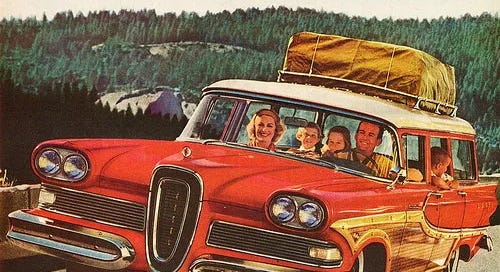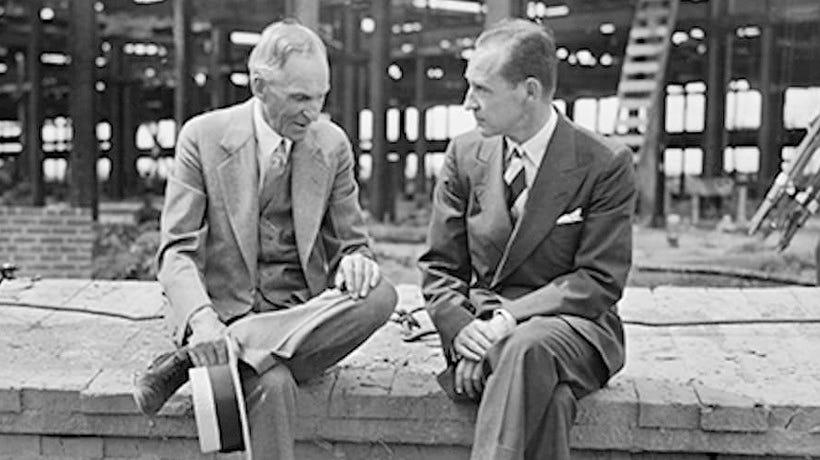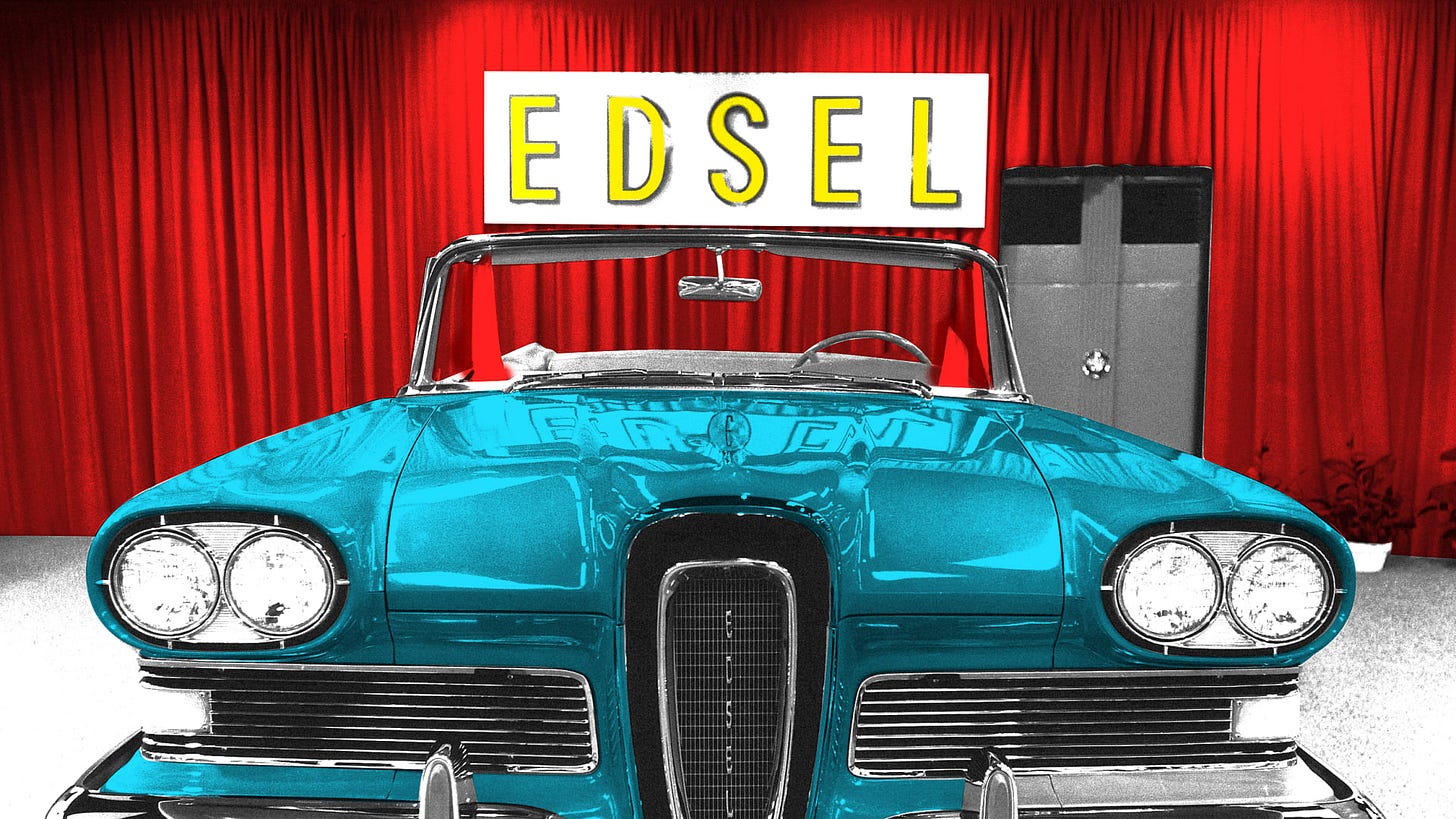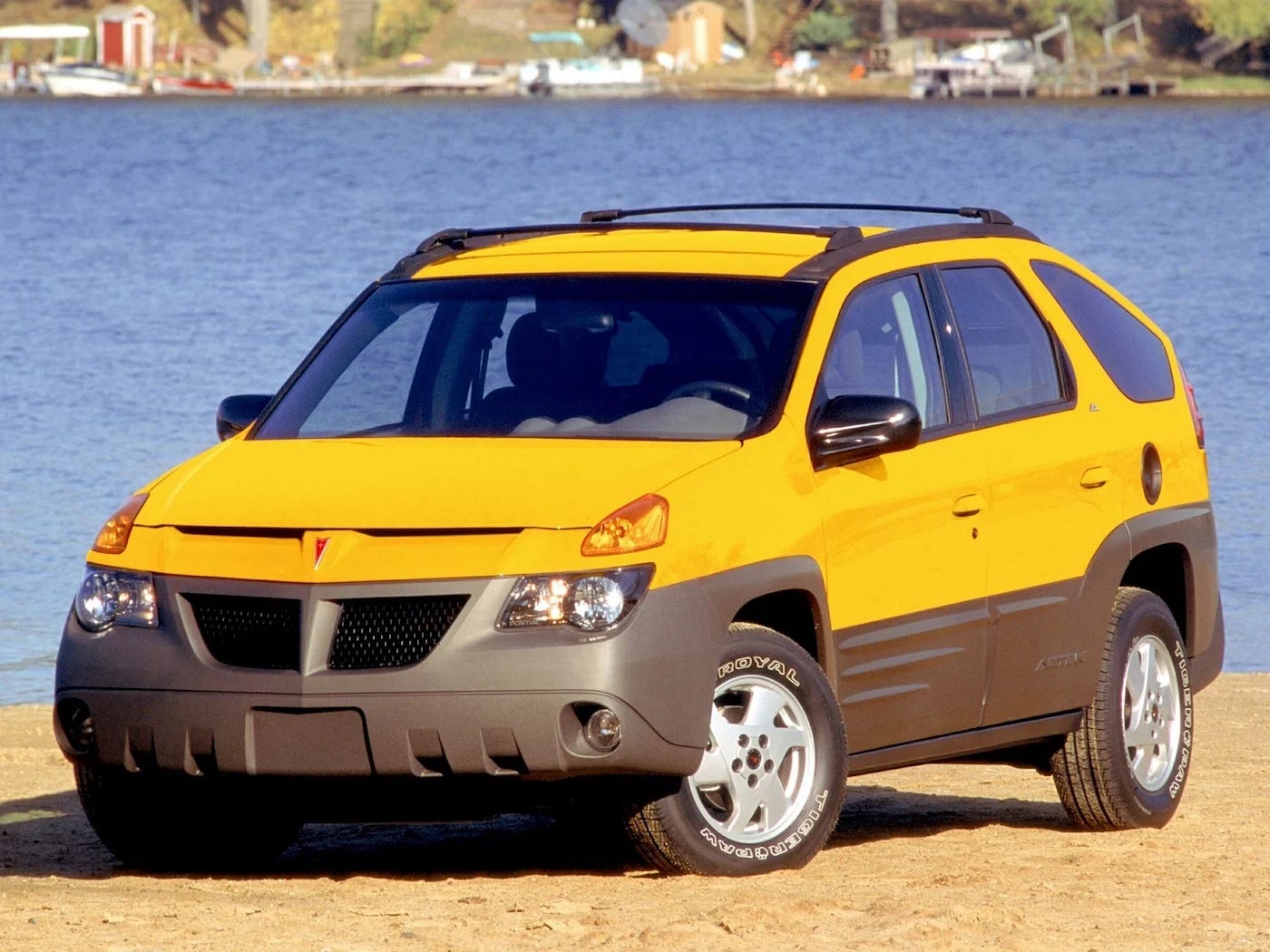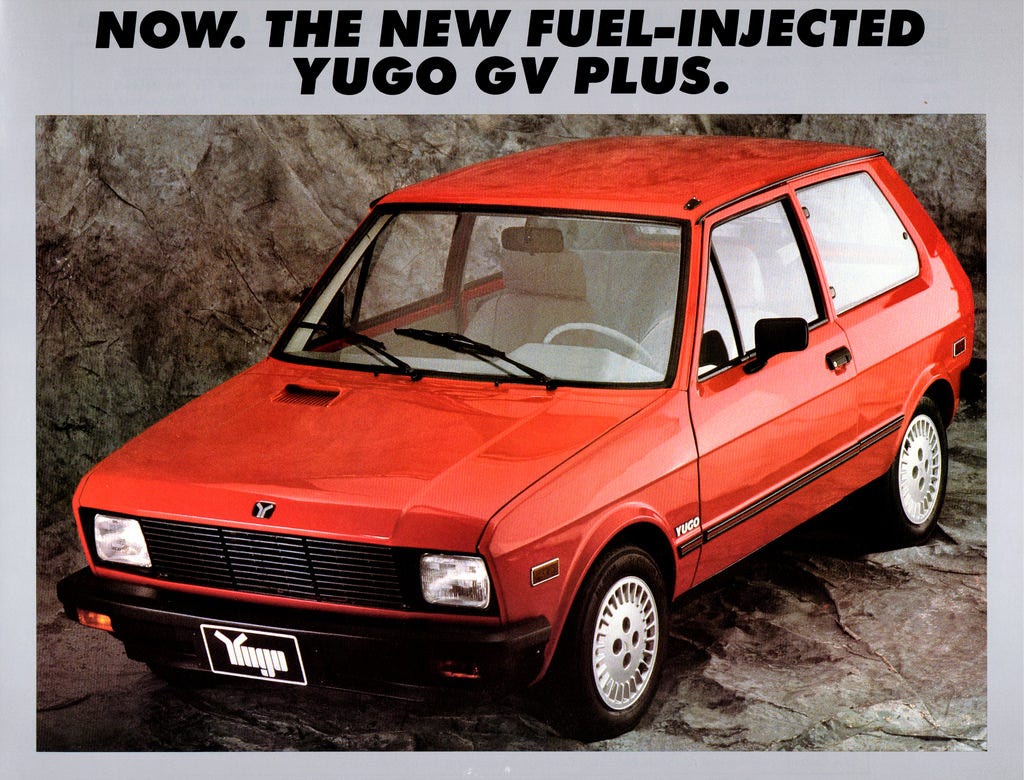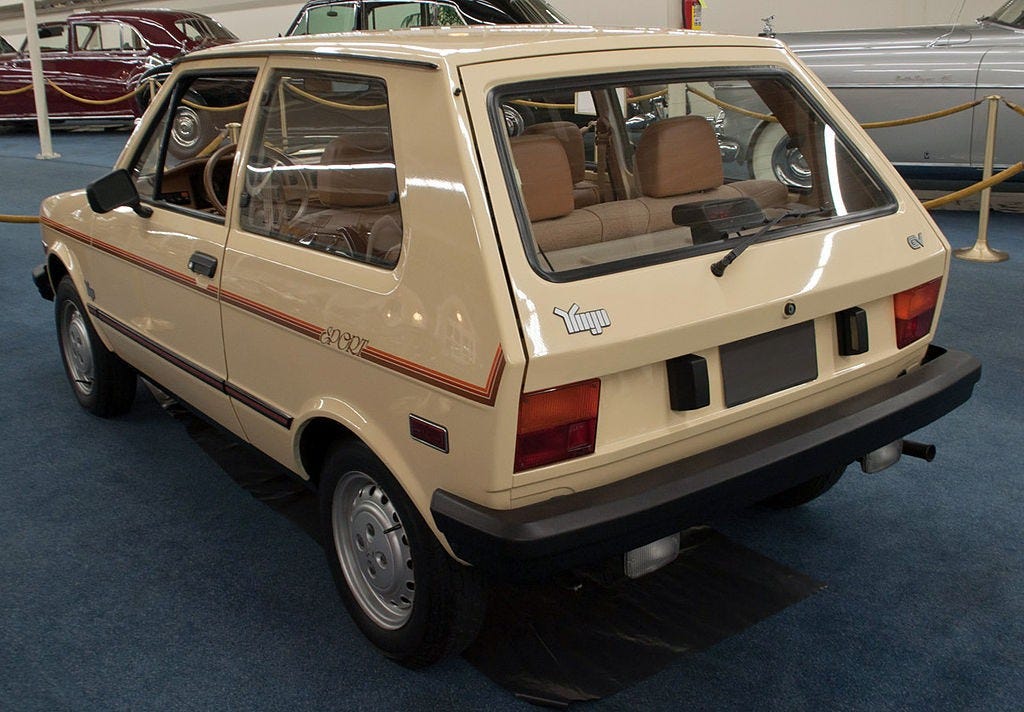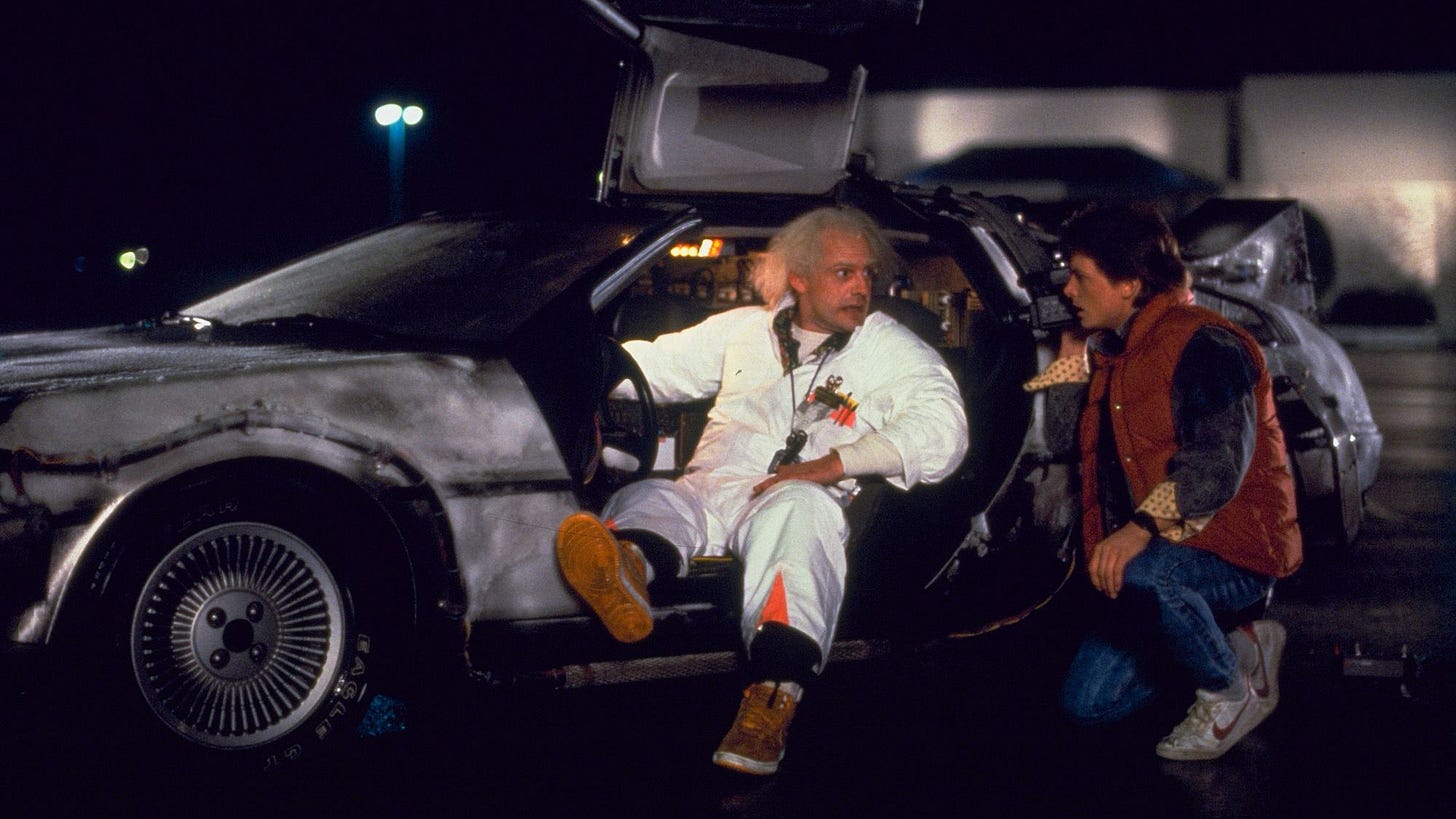🚗 Overhyped Cars That Turned Out to Be Lemons 🍋 (Part 4)
Part Four of 'Oops, We Made It Worse' (Part 4 of 7 Part Series)
Top of the Series: 🧯 Oops, We Made It Worse (Part 1)
Previous: 🥞 Branded Lies: When the Logo Whitewashes History (Part 3)
Oops, We Made It Worse – Part 4: 🚗 Overhyped Cars That Turned Out to Be Lemons 🍋
They came in with a roar and left with a tow truck.
This is what happens when marketing teams dream big, engineering departments take naps, and designers get possessed by chaos demons with access to AutoCAD.
When collaboration goes wrong, it doesn’t just stall—it rolls off the assembly line into the history books of regret.
In fact, that’s the kind of spectacular dysfunction I explore in my upcoming book, Collaborate Better—because whether you’re launching a new car or just trying to get your team to stop arguing over fonts, bad collaboration leads to beautiful disasters. (And yes, there’s a whole chapter on how not to end up like the Edsel.)
So let’s pop the hood on some of the most gloriously overhyped automotive catastrophes ever unleashed:
🔧 The Ford Edsel
“The Car of the Future!” (Future canceled due to lack of interest.)
In the 1950s, Ford wasn’t just launching a car—they were launching a prophecy. After 10 years of research and $250 million in development (equivalent to billions today), the Edsel was supposed to redefine the American automobile. It was a bold, futuristic statement from a company that had already transformed the world with the Model T.
And to top it all off, they named it after Edsel Ford—the only son of company founder Henry Ford. The name was meant to honor Edsel’s legacy as a former president of the company. The irony? Neither Henry Ford nor Edsel (who had died in 1943) had anything to do with the project. In fact, the company considered over 6,000 name options—including “Mongoose Civique” and “Utopian Turtletop”—before reluctantly settling on Edsel. It was intended to sound prestigious and refined. Instead, the public thought it sounded like a cough syrup or a mid-level dental hygienist.
When the car was finally unveiled, the public reaction wasn’t “Wow!”—it was more like, “...Wait, is that the front or the back?”
Followed quickly by, “Why does it look like a car sucking on a lemon?”
And then, almost unanimously: “I’m not paying for that.”
That infamous grille—meant to resemble a “rolling waterfall”—looked more like a toilet seat mid-flush. Or, depending on your angle, a horse collar with delusions of grandeur. Ford’s designers thought it would be elegant and distinctive. The public thought it was a dare.
🚘 Public reception nosedived faster than a test dummy in a crash simulation.
Within months, sales sputtered. Instead of the 200,000+ cars Ford forecasted selling annually, the Edsel limped to about 63,000 in its first year. Customers were baffled by the bloated design, overloaded features, and a price tag that didn’t match the promised luxury—or the actual quality. Some early models leaked oil. Others literally fell apart on delivery. In short: it looked weird and it broke.
The hype machine crashed hard.
Ford’s marketing had promised a moonshot.
What people got was a chrome-plated dud that handled like a boat, looked like a prank, and depreciated faster than a day-old donut.
💥 The Rollback
Ford didn’t just hit the brakes—they yanked the parking brake, turned off the engine, and ghosted their own creation. By 1960, the Edsel was done. Less than three years after its hyped-up debut, Ford quietly buried the brand like a failed Vegas magician—no encore, no eulogy.
They dismantled the Edsel division, reassigned or let go thousands of employees, and let the remaining cars sit on lots like forgotten leftovers at a Tupperware party no one wanted to attend.
🚦 What Did Ford Learn?
Theoretically:
Don’t overpromise and underdeliver.
Don’t design by committee until the product looks like it was created in a bureaucratic fever dream.
And never name a car after the founder’s son if it’s going to look like a chrome hemorrhoid ring.
But did Ford really learn?
Eh… yes and no.
They went on to launch the Mustang just a few years later, proving they could bounce back—when they actually listened to the market instead of building hype around what executives hoped people wanted. The Mustang was lean, stylish, and targeted toward youth. The Edsel? It was like a midlife crisis in car form—with fins.
📝 Takeaway:
You can’t manufacture cool with cash alone.
You can't force futuristic with a weird shifter knob and ad copy.
And if your product makes people laugh before they test-drive it—you’re not launching a car. You’re launching a punchline.
🔩 The Pontiac Aztek
"Built for adventure. Designed by a committee that hated each other."
In the early 2000s, Pontiac was in trouble. GM was desperate to connect with a new generation—enter: Gen X. Rugged. Rebellious. Independent. A little angsty. They wanted a vehicle that said, “I camp on weekends, I’m edgy but responsible, and I might one day backpack through Peru... if I can get the time off.”
So GM’s pitch for the Pontiac Aztek was bold: an SUV for the X-treme lifestyle. A car that could take you from the boardroom to basecamp. One of its actual taglines? “Quite possibly the most versatile vehicle on the planet.” And it wasn’t just a slogan—they packed it with weird, earnest gimmicks to prove it:
A center console that doubled as a removable cooler
An optional tent attachment that turned the back into a “camping pod”
A built-in air compressor
And an available all-wheel drive system, perfect for… escaping ridicule
GM imagined it would become a cult classic, an icon of functional fun. It was the Swiss Army Knife of SUVs. But there was one small issue...
🚨 It looked like a sneeze in mid-freeze frame.
People didn’t just dislike the Aztek’s design—they were actively disturbed by it. Critics called it “a DustBuster on wheels,” “a design melted in the sun,” and “a Transformer that got stuck halfway through transforming and then gave up.”
It had a hunchback silhouette, angry insect eyes, and a plastic body cladding that looked like it was made from leftover kayak material. It was simultaneously overdesigned and under-thought, with an exterior that screamed, “Your teenage son designed this in Microsoft Paint.”
🧼 Public Reaction:
The car launched in 2000 to a chorus of confused stares and whispered, “...That’s it?” moments. While GM had hoped for “X-Games energy,” what they got was existential dread in crossover form. Even people who appreciated its functionality couldn’t get past its appearance. Imagine showing up to your camping trip with a car that makes trees cringe.
Sales were anemic. GM expected 75,000 units a year—they barely moved 27,000 in the first. And by year five, they had to pull the plug.
📉 The Rollback
Pontiac tried everything to salvage the Aztek. They muted the colors. Smoothed the edges. Toned down the cladding. But the damage was done. No amount of revision could erase the original first impression: “This car looks like anxiety feels.”
Eventually, GM euthanized the Aztek lineup in 2005, rolling it into a shallow grave next to the Saturn Ion and any lingering hopes of Pontiac surviving the 2008 financial crisis. The Aztek became a case study in how not to balance innovation with taste—a masterclass in over-indexing on utility while completely ignoring aesthetics.
💥 The Pop Culture Redemption (Sort of)
And then... Breaking Bad happened.
Suddenly, the Aztek was back—in all its awkward, tragic glory—driven by none other than Walter White. But this wasn’t brand resurrection. It was the ultimate metaphor: a brilliant man’s descent into moral decay, illustrated by a man who drives a car so ugly, even the cartels show pity. Walter White didn’t choose the Aztek. The Aztek chose him. It was the perfect companion for a chemistry teacher turned meth lord—functional, forgettable, and completely, unapologetically broken.
📝 Lessons Learned (Hopefully)
GM learned a few hard truths:
Function does not excuse form
Don’t design a vehicle by focus group Frankenstein
And maybe—just maybe—get actual designers involved before you approve the clay model
While the Aztek died a slow, awkward death, its spiritual successor—the Buick Enclave—learned to hide its camping gear behind sleeker lines and better materials. And in fairness, modern SUVs like the Kia Telluride and Ford Bronco Sport owe something to the Aztek’s gutsy, gear-hauling intentions. They just don’t look like rejected concept art from a dystopian Pixar short.
🔨 The Yugo
"The Affordable Car for Everyone! (Just bring your own tow truck.)"
When the Yugo hit U.S. shores in 1985, it arrived with a mission: Make car ownership accessible to the masses. Billed as “The Affordable Car for Everyone,” it had one unbeatable feature—a sticker price of just $3,990. That was about the same as a nice TV and a couch at the time. America, with its big dreams and bigger car payments, was intrigued.
This wasn’t just a car; it was social mobility in boxy form. The ads painted it as the vehicle of the people—a simple, economical, no-frills way to get from Point A to Point B.
Unfortunately, getting to Point B required divine intervention. Sometimes even Point A was a stretch.
Imported from then-communist Yugoslavia, the Yugo GV (short for "Great Value"—seriously) was based on a 1970s Fiat design, re-skinned and re-sold with all the grace of a microwave on roller skates. It came equipped with:
A 1.1-liter engine that sounded like an angry blender
Vinyl seats that screamed (and so did your passengers)
An interior so spartan it made IKEA furniture look luxurious
Windshield wipers that wiped… most of the time
But hey—it was cheap, right?
💸 Public Reception:
Initially? People were curious. Car buyers desperate for a new ride at a used-car price gave it a shot. Journalists were cautiously optimistic. After all, how bad could it be?
Answer: bad. Just… bad.
The Yugo quickly became the punchline of the automotive world. It was mocked in stand-up routines, roasted by car critics, and universally panned by owners who realized their glove compartments were more reliable than the engine.
Here’s a sampling of what the public experienced:
🚨 Sudden breakdowns in broad daylight
🚗 Doors that refused to close—or worse, open
🧯 Plastic trim that peeled like sunburned skin
🛠 Engines that seemed insulted by the very idea of uphill roads
😬 A 0-to-60 time best measured with a calendar
Gravity wasn’t a guarantee. Neither was steering. And if you made it through a long trip without breaking down, you didn’t just arrive—you became legend.
🧼 The Rollback
Importers tried to reassure buyers. Yugo America ran damage control faster than the cars could hit 30 mph. They offered warranty extensions, downplayed mechanical horror stories, and pumped out PR fluff like, “Well, you get what you pay for!”—which, it turns out, is not a selling point.
But the damage was done. Reviews were brutal. Word-of-mouth was toxic. Late-night hosts had a field day. And by the early 1990s, the Cold War wasn’t the only thing collapsing—Yugo’s reputation was in ruins.
Eventually, Yugo America folded like a gas station umbrella, and the car quietly vanished from dealerships, appearing only in junkyards and the occasional ditch.
📉 The Takeaways
Did the auto industry learn anything? Kind of.
The Yugo taught automakers and marketers a few timeless lessons:
🚫 You can’t polish a lemon—even with chrome trim.
🧠 Cheap can’t replace reliable.
🎯 Marketing hype only works until the first pothole.
It also proved that just because you can slap a price tag on something doesn’t mean people should buy it. Affordability without functionality is just charity work for tow truck drivers.
Today, the Yugo remains a case study in cost-cutting gone catastrophic. It tried to democratize driving—and instead, created an international cautionary tale that still makes mechanics twitch.
🎁 Final Verdict:
The Yugo delivered on one promise—it brought people together. Mostly in waiting rooms, on the sides of highways, or pushing it uphill together as a community bonding activity.
It’s not just a bad car. It’s an icon of what not to do when designing, building, and selling a product meant to keep people alive on the freeway.
⚙️ The DeLorean DMC-12
“Built for the future. Drove like it forgot the present.”
Few cars have ever launched with more dramatic flair—or fizzled faster—than the DeLorean DMC-12. On paper, this thing was a sci-fi fever dream:
Brushed stainless steel body
Futuristic gullwing doors
Designed by Giorgetto Giugiaro, the man behind actual legends like the Maserati Bora and the VW Golf
And the cherry on top? Created by John Z. DeLorean, a renegade GM exec with Bond-villain cheekbones and a vision to shake up the industry
What could go wrong?
Everything.
🚀 The Hype:
The DMC-12 wasn’t just a car—it was supposed to be a revolution on wheels. DeLorean promised innovation, elegance, and Euro-style performance wrapped in a never-rust, spaceship-looking package.
The advertising pitched it like it came from tomorrow. The gullwing doors alone were supposed to be a cultural reset. And that stainless steel? A bold middle finger to paint jobs everywhere. It screamed luxury, modernity, and I can’t be bothered with fingerprints.
John DeLorean's goal? To compete with Porsche and Ferrari, while appealing to ethically-minded yuppies who wanted performance and conscience (it was built in Northern Ireland, in a region desperate for jobs). The dream was equal parts fast car and social justice.
🏎 The Reality:
And then people actually drove one.
0–60 mph in 10.5 seconds—slower than a Prius towing a trailer of regret
A 130-horsepower V6 that wheezed like a broken leaf blower
Handling that felt like the steering column was haunted by a drunk ghost
A speedometer that topped out at 85, which tells you everything you need to know
That iconic stainless steel body? Looked cool, sure—but it was heavy, scratched easily, and was basically a fingerprint magnet with doors that opened like they were trying to make a dramatic entrance at a party you weren’t invited to.
Worse, the car launched in 1981 into a recession. The target market—young, well-off dreamers—were now more worried about gas prices and mortgages than stepping into a personal spaceship that cornered like a couch on rollerblades.
Oh, and reliability? Let’s just say… Back to the Future is the only time a DeLorean reliably traveled long distances.
💥 Public Reaction:
At first, people were dazzled. Then they got behind the wheel and immediately questioned their life choices. Reviewers panned the sluggish performance, the cramped interior, and the fact that you could see the dream dying in the rearview mirror.
Critics called it a “style-over-substance showroom prop.” One even said it was “a great conversation piece parked in your driveway… because it won’t get you anywhere else.”
📉 The Rollback:
Within two years, production halted. Only around 9,000 units were ever made.
Meanwhile, John DeLorean got arrested in an FBI sting for trafficking $24 million worth of cocaine—allegedly to fund his collapsing car company. (Yes, the DeLorean saga had a drug subplot. You couldn’t write this stuff without getting notes that it was “too unrealistic.”)
The company folded faster than the gullwing doors on a windy day. The DMC-12 quietly disappeared from lots, leaving behind a confused fan base, unpaid workers, and collectors wondering if they’d just bought a very expensive paperweight.
🎥 The Hollywood Hail Mary:
Then, like a stainless steel phoenix rising from a time paradox, Hollywood stepped in.
Back to the Future turned the DeLorean into a pop culture legend, solidifying its immortality not with performance, but with plutonium, flux capacitors, and Michael J. Fox behind the wheel. In a twist of cosmic irony, the car became iconic after it failed—immortalized as the world’s most stylish time machine that, let’s be honest, probably wouldn’t have made it to 88 mph on its own.
📝 Takeaways:
So, what did we learn?
🚫 Stainless steel does not equal performance
🚪 Gullwing doors do not equal innovation
🏁 Flash doesn’t matter if the function is trash
💡 A great story will outlive a bad product… if you’re lucky enough to land a Spielberg cameo
The DeLorean DMC-12 was a failure in execution, a legend in hindsight, and a masterclass in how hype can outlive reality if the design is just wild enough.
Iconic? Sure.
Functional? Barely.
Memorable? Absolutely.
Because at the end of the day, it’s not about how you drive…
It’s about how epically you stall.
🚗🔥 Poll Time: Which Car Would You Trust the Least on a Long Road Trip?
You’ve got a suitcase, a cooler full of snacks, and 900 miles to go.
Which of these legendary lemons would you avoid like a pothole at 70 mph?
🛑 Pick your panic ride:
🧻 Ford Edsel – Bold design. Toilet-seat grille. Sold like expired yogurt.
🤖 Pontiac Aztek – Versatility meets visual confusion.
🪫 Yugo – The most affordable car in America. For a reason.
🚪 DeLorean DMC-12 – Stainless steel style, powered by hope and disappointment.
👀 Cast your vote—and tell us in the comments why your pick terrifies you the most. Bonus points for personal horror stories.
🚨 Branding Lessons from the Junkyard
These weren’t just engineering blunders—they were branding implosions.
When the promise doesn’t match the product, your audience won’t just be disappointed—they’ll remember.
If your launch earns nicknames like:
💀 “Deathtrap”
🛑 “Disaster on Wheels”
🚫 “The Car That Killed the Brand”
…your PR didn’t deliver a product—they delivered a punchline.
📚 Next in the series: 🔜 Coming Up in Part 5…
Some brands implode because of bad products.
Others? Because the founder won’t stop tweeting through the apocalypse.
Next week, we’re diving into the chaos engine himself:
🧨 Elon Musk: Breaking His Own Toys in Real Time
From Cybertruck delays and AI brain chips in livestock to the slow, flaming rebrand of Twitter into whatever X is now—Elon’s not just a disruptor anymore. He’s a walking case study in how to alienate your base, dilute your mission, and tank your brand while live-streaming it in 4K.
📉 Visionary? Maybe.
🎪 Chaos goblin with a billion-dollar megaphone? Definitely.
Buckle up. Part 5 is going full tilt into the electric car crash of modern brand sabotage.
Next Blog In This Seven Part Series: 🧨 Elon Musk: Breaking His Own Toys in Real Time 💣 (Part 5)
#OopsWeMadeItWorse #BrandingFails #AutoDisasters #FordEdsel #Yugo #PontiacAztek #DeLorean #MarketingFails #SubstackSeries

